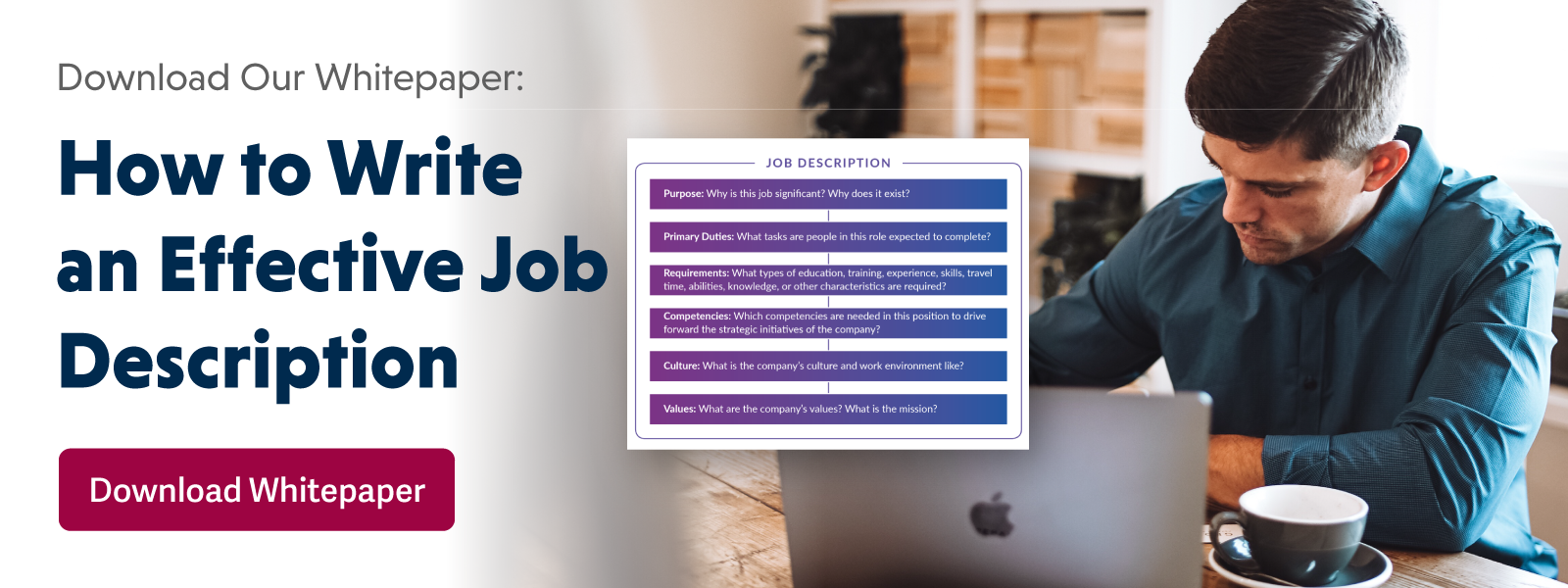64% of applicants wouldn’t respond to a job posting with a poorly written or confusing job title. And 60% find jargon to be annoying. Writing effective job descriptions is a challenging task, but it has a major impact on the quality of applicants your business receives. Small businesses can be especially susceptible to poorly written job descriptions — with a smaller staff and more at stake per individual performance. So, attracting the right talent is critical to business success.
Did you know that 64% of job applicants don't respond to bad #JobDescriptions? Learn how @CaliperCorp says to write job descriptions that work: Share on XOften, job descriptions are written based on a template or use a framework that’s a one-size-fits-all, generalized version of a role written from a company viewpoint. For experienced workers who aren’t in a hurry or are more passive about finding work, this approach isn’t going to grab the attention of highly skilled individuals looking for an exciting new challenge. Using a checklist of responsibilities and the skills and qualifications necessary to accomplish them doesn’t work. And for small businesses or start-ups who don’t have a brand identity to leverage, making your description something meaningful, interesting, and informative is critical.
It’s important to remember that your hiring process begins with your job description. It’s a key moment when initial expectations are set for your candidates. Creating descriptive, thorough job descriptions that are highly relevant to your specific positions is worth the time and investment.
Download Our Whitepaper:
How to Write an Effective Job Description
What Makes an Effective Job Description?
You want to write job descriptions that effectively:
- Encourage unqualified job seekers to self-select out
- Give you a complete picture of what a candidate needs to possess to be successful in the role
- Help you find candidates quickly when the role needs to be filled urgently
- Cover the business in any legal issues that should arise during the interview process
So how do you go about writing a description that’s effective? Consider this process:
- Purpose: Why does the role exist? How does it serve the organization?
- Primary Duties: What tasks are people in this role expected to complete?
- Requirements: What requisites are needed in order to succeed?
- Competencies: Which competencies are needed in this position to excel and thrive?
- Culture: What is the company’s culture and work environment like?
- Values: What are the company’s mission, vision, and values?
How to Accurately Represent the Role
Creating the most thorough and complete job description for your role starts with an in-depth job analysis. To do this, you or a third-party consultant, like Caliper, could hold conversations with stakeholders, supervisors, and high performers to determine business needs, understand the impact the role has on the organization, determine performance expectations and competencies for the role, and understand the day-to-day needs. Here are some questions to answer when thinking about how to craft your description:
- What are the day-to-day needs of the position?
- What are the core competencies necessary to perform the role?
- What are the outcomes that denote success, and how will they be measured?
- What does the organization need from the role, both today and in the future?
When you frame the role within these questions, you can use the information gleaned from these conversations to create relevant job descriptions to help you hire the right people for the right job. Comprehensive answers to these questions aids both hiring managers and applicants to thoroughly understand the needs of the business, how the role should be performed, and what’s needed to so.
Re-Evaluate Often
But the process doesn’t stop there. Once the job description has been written, that doesn’t mean the task is completed. It’s important to remember to revisit your job descriptions often. Once a year, re-examine your expectations and needs. With the world of work changing rapidly, it’s important to understand the dynamic needs of each position and update them accordingly. In doing so, you ensure that the requirements you need for today and the future are accurate, up-to-date, and consistent with organizational culture and expectations.
To learn more about the ways Caliper can help you understand and examine your job descriptions and craft outstanding job listings that attract the caliber of talent you’re looking for, download our whitepaper on the topic. For other ways that Caliper can help get the best out of your people, reach out to our experts today.


